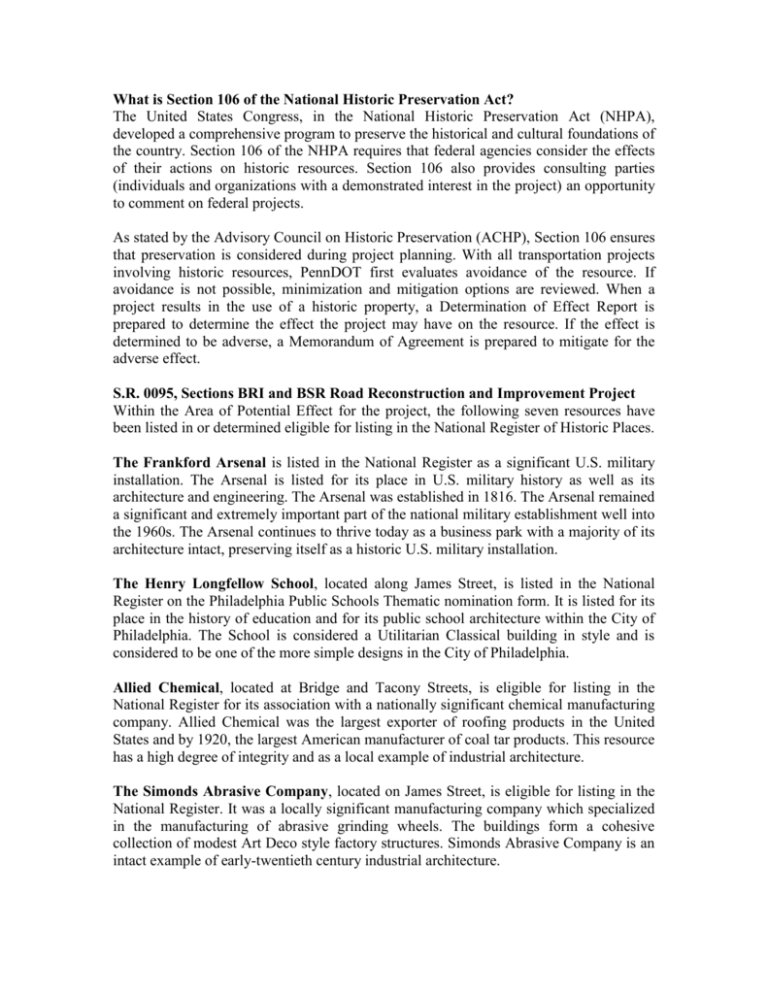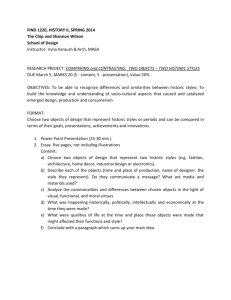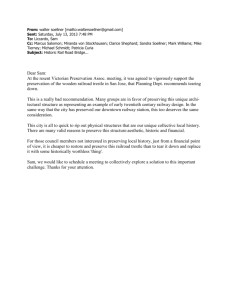What is Section 106 of the National Historic Preservation
advertisement

What is Section 106 of the National Historic Preservation Act? The United States Congress, in the National Historic Preservation Act (NHPA), developed a comprehensive program to preserve the historical and cultural foundations of the country. Section 106 of the NHPA requires that federal agencies consider the effects of their actions on historic resources. Section 106 also provides consulting parties (individuals and organizations with a demonstrated interest in the project) an opportunity to comment on federal projects. As stated by the Advisory Council on Historic Preservation (ACHP), Section 106 ensures that preservation is considered during project planning. With all transportation projects involving historic resources, PennDOT first evaluates avoidance of the resource. If avoidance is not possible, minimization and mitigation options are reviewed. When a project results in the use of a historic property, a Determination of Effect Report is prepared to determine the effect the project may have on the resource. If the effect is determined to be adverse, a Memorandum of Agreement is prepared to mitigate for the adverse effect. S.R. 0095, Sections BRI and BSR Road Reconstruction and Improvement Project Within the Area of Potential Effect for the project, the following seven resources have been listed in or determined eligible for listing in the National Register of Historic Places. The Frankford Arsenal is listed in the National Register as a significant U.S. military installation. The Arsenal is listed for its place in U.S. military history as well as its architecture and engineering. The Arsenal was established in 1816. The Arsenal remained a significant and extremely important part of the national military establishment well into the 1960s. The Arsenal continues to thrive today as a business park with a majority of its architecture intact, preserving itself as a historic U.S. military installation. The Henry Longfellow School, located along James Street, is listed in the National Register on the Philadelphia Public Schools Thematic nomination form. It is listed for its place in the history of education and for its public school architecture within the City of Philadelphia. The School is considered a Utilitarian Classical building in style and is considered to be one of the more simple designs in the City of Philadelphia. Allied Chemical, located at Bridge and Tacony Streets, is eligible for listing in the National Register for its association with a nationally significant chemical manufacturing company. Allied Chemical was the largest exporter of roofing products in the United States and by 1920, the largest American manufacturer of coal tar products. This resource has a high degree of integrity and as a local example of industrial architecture. The Simonds Abrasive Company, located on James Street, is eligible for listing in the National Register. It was a locally significant manufacturing company which specialized in the manufacturing of abrasive grinding wheels. The buildings form a cohesive collection of modest Art Deco style factory structures. Simonds Abrasive Company is an intact example of early-twentieth century industrial architecture. The Pennsylvania Railroad between Philadelphia and New York is eligible for listing in the National Register and is an important transportation resource in the tri-state area as well as an intact example of railroad engineering. This linear resource features both an elevated track and an electrified rail-line. The Pennsylvania Railroad between Philadelphia and Southern New Jersey is eligible for listing in the National Register and is an important transportation resource. This rail-line was one of the first to bridge the Delaware River, eventually replacing river ferries as an alternative transportation method into Southern New Jersey. The Railroad is also important for its early railroad engineering featuring electrified rail-lines. The Gillinder & Sons Glass Company, located at Tacony Street and Devereaux Avenue, was determined eligible for listing in the National Register as one of the most highly respected glass manufacturers in the City of Philadelphia. Gillinder & Sons made glass for gas fixtures and pioneered in the manufacture of glass for electrical fixtures. The plant was at one time the largest firm of its type in the country. The Tacony plant continues to retain its integrity and significance as an example of industrial architecture. For more information regarding the historic properties within the project area, please contact: Pennsylvania Department of Transportation Engineering District 6-0 7000 Geerdes Boulevard King of Prussia, PA 19406 Monica Harrower, Cultural Resources Professional









